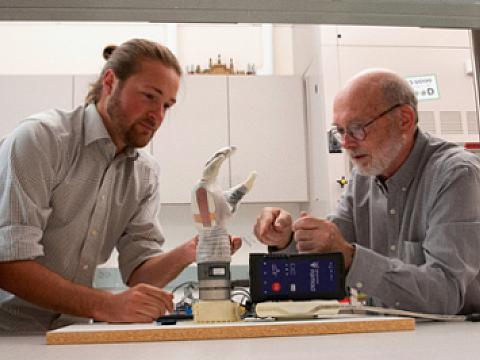
Star Wars-Inspired Prosthetic Lets Amputees Move and Feel
In the United States, 1.6 million individuals suffer from limb loss. The disabilities associated with limb loss are not just physical but also emotional and psychological, as many individuals who have lost a limb suffer from chronic pain and depression. Current prostheses are cumbersome, and as a result, nearly half of amputees stop using them.
Jacob George, PhD, director of the Utah NeuroRobotics Lab and an assistant professor in electrical and computer engineering and physical medicine and rehabilitation, is helping develop a motorized limb covered with a silicone “skin” called the LUKE arm, named after the robotic hand that Luke Skywalker receives in the movie, “The Empire Strikes Back.” Amputees can move the prosthetic with their thoughts; the device also restores a sense of touch.
“Imagine you’ve just woken up in the hospital to find out that both of your hands have been amputated,” said George, who was named to Forbes’ 30 Under 30 list in the Science category in 2022. “How do you go about your daily life? How do you play catch with your son or your daughter? And importantly, how do you feel the world around you or hold hands with a loved one?”
Most amputees today are still given a body-powered hook, based on American Civil War-era technology. Alternatively, they may be outfitted with a cosmetic hand, which looks more appealing but offers little functionality. Or they may receive an articulated limb that recreates the human hand’s movements, but is controlled via sensors that capture foot movements, so that wearers cannot walk and use their hands at the same time.
“What if we could control an advanced bionic arm simply with our thoughts?” George asked. “It might sound kind of crazy. But it’s not if you remember that every single day, we’re controlling our hands with our thoughts naturally.”
“What if we could control an advanced bionic arm simply with our thoughts?”
Normally, when thinking about moving your hand, an electrical signal is generated in your brain and then transmitted down through your nerves to muscles that execute a movement. George and colleagues worked with two University of Utah spin-off companies, Blackrock Neurotech and Ripple Neuro, to implant tiny sensors into the arm nerves and muscles to tap those naturally existing electrical signals. George is working to create an artificial intelligence system that translates those signals into dexterous arm and hand movements of the LUKE arm, initially created by DEKA Research 15 years ago.
“So truly, when you think about moving your hand, it would just happen naturally, seamlessly,” George said.
Importantly, the same system can also restore a sense of touch.
When the mechanical hand makes contact with an object, it records forces applied to the fingertips. The artificial intelligence system then converts those forces into electrical signals that are sent back up the body’s nerves to the brain so the wearer perceives touch as if it were coming from their missing hand.
George and colleagues have demonstrated that the LUKE arm can be viable for many years. Their improvements to its control have also resulted in improved dexterity, reduced chronic pain, and most importantly, a sense of “embodiment.”
“This means that the prosthetic hand actually starts to become incorporated into your body image,” said George, who is now helping to move the LUKE arm into clinical trials after it recently earned FDA approval for an in-home study of individuals using the device for everyday tasks. “At that point, it’s no longer just a tool, but it starts to be something that you would consider your own hand.”
Development of the LUKE arm has been the culmination of decades of research at the U based on pioneering work from Richard A. Normann, PhD, emeritus distinguished professor, and ongoing research from Gregory A. Clark, PhD, associate professor, both from the Department of Biomedical Engineering. Funding for the research was provided by federal agencies such as the Defense Advanced Research Projects Agency and the National Science Foundation.
- Written by Chris Palmer
